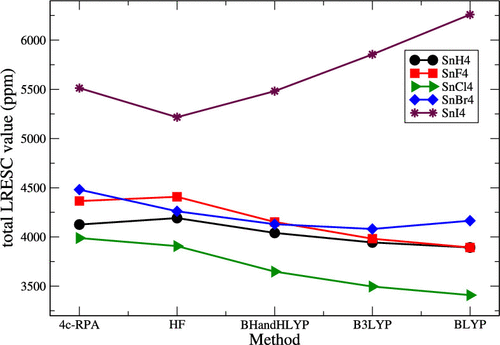当前位置:
X-MOL 学术
›
J. Chem. Inf. Model.
›
论文详情
Our official English website, www.x-mol.net, welcomes your feedback! (Note: you will need to create a separate account there.)
Performance of the LRESC Model on top of DFT Functionals for Relativistic NMR Shielding Calculations.
Journal of Chemical Information and Modeling ( IF 5.6 ) Pub Date : 2020-01-09 , DOI: 10.1021/acs.jcim.9b00912 Juan I Melo 1 , Alejandro F Maldonado 2 , Gustavo A Aucar 2
Journal of Chemical Information and Modeling ( IF 5.6 ) Pub Date : 2020-01-09 , DOI: 10.1021/acs.jcim.9b00912 Juan I Melo 1 , Alejandro F Maldonado 2 , Gustavo A Aucar 2
Affiliation

|
The linear response within the elimination of the small component model (LRESC) is an insightful and computationally efficient method for including relativistic effects on molecular properties like the nuclear magnetic shielding constants, spin-rotation constant, g-tensor, and electric field gradient of heavy atom containing molecules with atoms belonging up to the sixth row of the periodic table. One of its main advantages is its capacity to analyze the electronic origin of the different relativistic correcting terms. Until now, it was always applied on top of Hartree-Fock ground-state wave functions (LRESC/HF) to calculate and analyze NMR shieldings. In this work, we show the performance of the LRESC formalism on top of some density functional theory (DFT) functionals to compute tin shielding constants in SnX4 (X = H, F, Cl, Br, I) molecular systems. We analyze the performance of each LRESC/DFT scheme on reproducing the electronic mechanisms of the shieldings, taking as a benchmark the results of relativistic calculations at the RPA level of approach (4c/RPA). As in previous works, we divide the LRESC relativistic correcting terms into two groups: core-dependent and ligand-dependent contributions. It is shown here that core-dependent corrections are well-reproduced for the selected DFT functionals, but some differences arise in the ligand-dependent ones. We focus on the performance of different functionals, including the same electron correlation part but containing different amounts of HF exchange. The best results are obtained for the BHandHLYP functional (50% of HF exchange) and the worst for BLYP (0%). When the percentage of HF exchange increases, ligand-dependent contributions are better described, and the final LRESC/DFT results are closer to those obtained with LRESC/HF and 4c/RPA methods. The spin-orbit correction to the shielding constant is one of the main ligand-dependent contributions (there are two more) with total value depending on the amount of HF exchange included in the functional. When the amount of HF exchange decreases, the spin-orbit contribution becomes larger, overestimating the shielding constant even when nonrelativisitc DFT values are much smaller than the nonrelativistic HF ones, as it happens for the heaviest molecular system studied here (SnI4).
中文翻译:

LRESC模型在相对论NMR屏蔽计算的DFT功能之上的性能。
消除小组件模型(LRESC)内的线性响应是一种有见地且在计算上有效的方法,用于包括对分子特性的相对论效应,例如核磁屏蔽常数,自旋旋转常数,g张量和重的电场梯度包含原子的元素,这些原子的原子属于元素周期表的第六行。它的主要优点之一是具有分析不同相对论校正术语的电子起源的能力。到目前为止,它始终被应用在Hartree-Fock基态波函数(LRESC / HF)之上,以计算和分析NMR屏蔽。在这项工作中,我们将在一些密度泛函理论(DFT)泛函的基础上展示LRESC形式主义的性能,以计算SnX4中的锡屏蔽常数(X = H,F,Cl,Br,一)分子系统。我们以RPA方法(4c / RPA)的相对论计算结果为基准,分析了每种LRESC / DFT方案在再现屏蔽层电子机制方面的性能。与以前的工作一样,我们将LRESC相对论校正术语分为两类:核心依赖性贡献和配体依赖性贡献。在此表明,对于所选的DFT功能,核心依赖的校正得到了很好的再现,但是配体依赖的校正出现了一些差异。我们专注于不同功能的性能,包括相同的电子相关部分,但包含不同量的HF交换。对于BHandHLYP功能(50%的HF交换)获得最佳结果,而对于BLYP(0%)则获得最差的结果。当HF交换的百分比增加时,更好地描述了配体依赖性的贡献,并且最终的LRESC / DFT结果更接近于使用LRESC / HF和4c / RPA方法获得的结果。对屏蔽常数的自旋轨道校正是主要的依赖配体的贡献之一(还有两个),其总值取决于功能中所含的HF交换量。当HF交换量减少时,自旋轨道贡献变大,即使非相对论DFT值比非相对论HF值小得多,自旋轨道贡献也被高估了,因为在这里研究的最重分子系统(SnI4)都会发生这种情况。对屏蔽常数的自旋轨道校正是主要的依赖配体的贡献之一(还有两个),其总值取决于功能中所含的HF交换量。当HF交换量减少时,自旋轨道贡献变大,即使非相对论DFT值比非相对论HF值小得多,自旋轨道贡献也被高估了,因为在这里研究的最重分子系统(SnI4)都会发生这种情况。对屏蔽常数的自旋轨道校正是主要的依赖配体的贡献之一(还有两个),其总值取决于功能中所含的HF交换量。当HF交换量减少时,自旋轨道贡献变大,即使非相对论DFT值比非相对论HF值小得多,自旋轨道贡献也被高估了,因为在这里研究的最重分子系统(SnI4)都会发生这种情况。
更新日期:2020-01-09
中文翻译:

LRESC模型在相对论NMR屏蔽计算的DFT功能之上的性能。
消除小组件模型(LRESC)内的线性响应是一种有见地且在计算上有效的方法,用于包括对分子特性的相对论效应,例如核磁屏蔽常数,自旋旋转常数,g张量和重的电场梯度包含原子的元素,这些原子的原子属于元素周期表的第六行。它的主要优点之一是具有分析不同相对论校正术语的电子起源的能力。到目前为止,它始终被应用在Hartree-Fock基态波函数(LRESC / HF)之上,以计算和分析NMR屏蔽。在这项工作中,我们将在一些密度泛函理论(DFT)泛函的基础上展示LRESC形式主义的性能,以计算SnX4中的锡屏蔽常数(X = H,F,Cl,Br,一)分子系统。我们以RPA方法(4c / RPA)的相对论计算结果为基准,分析了每种LRESC / DFT方案在再现屏蔽层电子机制方面的性能。与以前的工作一样,我们将LRESC相对论校正术语分为两类:核心依赖性贡献和配体依赖性贡献。在此表明,对于所选的DFT功能,核心依赖的校正得到了很好的再现,但是配体依赖的校正出现了一些差异。我们专注于不同功能的性能,包括相同的电子相关部分,但包含不同量的HF交换。对于BHandHLYP功能(50%的HF交换)获得最佳结果,而对于BLYP(0%)则获得最差的结果。当HF交换的百分比增加时,更好地描述了配体依赖性的贡献,并且最终的LRESC / DFT结果更接近于使用LRESC / HF和4c / RPA方法获得的结果。对屏蔽常数的自旋轨道校正是主要的依赖配体的贡献之一(还有两个),其总值取决于功能中所含的HF交换量。当HF交换量减少时,自旋轨道贡献变大,即使非相对论DFT值比非相对论HF值小得多,自旋轨道贡献也被高估了,因为在这里研究的最重分子系统(SnI4)都会发生这种情况。对屏蔽常数的自旋轨道校正是主要的依赖配体的贡献之一(还有两个),其总值取决于功能中所含的HF交换量。当HF交换量减少时,自旋轨道贡献变大,即使非相对论DFT值比非相对论HF值小得多,自旋轨道贡献也被高估了,因为在这里研究的最重分子系统(SnI4)都会发生这种情况。对屏蔽常数的自旋轨道校正是主要的依赖配体的贡献之一(还有两个),其总值取决于功能中所含的HF交换量。当HF交换量减少时,自旋轨道贡献变大,即使非相对论DFT值比非相对论HF值小得多,自旋轨道贡献也被高估了,因为在这里研究的最重分子系统(SnI4)都会发生这种情况。


























 京公网安备 11010802027423号
京公网安备 11010802027423号